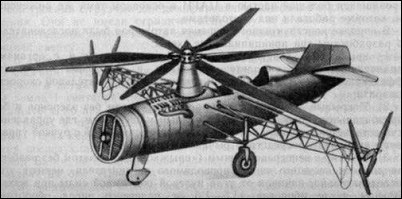
| Bratukhin 11-EA PV 1953 |  |
 |

| Bratukhin 11-EA PV 1953 |  |
 |
|
Designed 1934, this used Bratukhin�s rotor with alternate large articulated blades and small rigid blades but sealed up to absorb power of large US water-cooled V-12 engine. Latter mounted in nose of steel-tube fuselage covered in fabric for streamlining, with tandem cockpits at rear behind main rotor pylons. Engine arranged facing to rear with reduction gear driving second reduction gearbox at foot of rotor shaft. Auxiliary drive from rear wheelcase to three-blade cooling fan drawing air through main radiator on nose. Rotor torque reacted by two 2250mm three-blade propellers near tips of small fixed wing. Complete aeroplane flght controls � ailerons, elevators, rudder � in addition to improved cyclic/collective controls on main rotor. Intention was to test as helicopter and later arrange for drive to main rotor to be disconnected and aircraft flown as autogyro, with all power used for forward populsion via propellers, with aeroplane flight control. 11-EA was completed summer 1936 and completed tethered testing on a platform, using front cockpit as observer and rear as pilot, though dual controls provided. Considerable difficulties with distribution of power, main blade construction and maintenance of steady height whilst varying pull power of propellers. Late 1937 wave of arrests removed Chyeremukhin, Izakson and many other helicopter engineers and virtually halted further work through fear of accusation of sabotage. After much calculation Bratukhin dared 1938 to begin alterations and in spring 1938 aircraft emerged as 11-EA PV (Propulsivnyi Variant). Main rotor hub fitted with improved blades entirely dural with better profile. Auxiliary propellers replaced by pairs of anti-torque rotors from 5-EA mounted at tips of outriggers of welded steel tube, increasing distance between thrus axes from 8.0 to 11.0m. Removal of wing improved vertical performance, and smaller screws at greater distance from fuselage reduced power loss in countering torque. Idea of making convertible helicopter autogyro abandoned. PV ready late 1939 and in Chyeremukhin�s absence D.I.Savelyev took over flight test, making tethered flights early 1940 and free flights from October. Under test director V.P.Lapisov reconstructed machine demonstrated excellent lifting power and good control, but ancient engine no longer ran well (no spares for many years) and programme halted early 1941 for new Soviet engine. Never flew again. Bill Gunston "The Osprey's Encyclopedia of Russian Aircraft", 2000
After series of tests the 11-EA helicopter was rebuilt keeping in mind more systematic study of controls. Wing was replaced frame structure supporting control rotors, borrowed temporarily from older models 1-EA and 3-EA. Main rotor blades were of all metal construction. Systematically studied in 1940-1941 by engineer-pilot D.I.Saveljev and designer V.P.Lapisov. Performance was good, aircraft was stable and responsive to controls. Tests stopped due to worn engine.
|